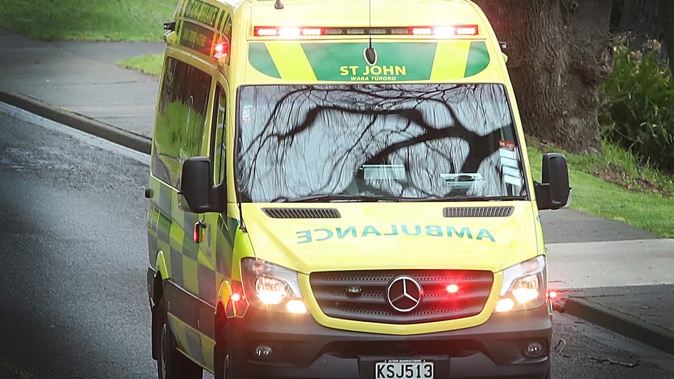

When a man’s blood tests indicated a possible heart attack his doctor told him to call 111 for an ambulance to get him to the emergency department immediately.
But, when the man relayed that information to the 111 operator he was told his doctor was “probably being a bit cautious” and was triaged as being potentially serious, but not in an immediately life-threatening situation.
Fire and Emergency NZ (Fenz) was instead sent in the first instance and it was another hour until a St John ambulance finally arrived to take over the man’s care.
“We ... wasted two hours waiting around for St John to do nothing,” the man said in a complaint to the Health and Disability Commissioner (HDC) about how Hato Hone St John handled his call for help that day.
The man, who was eventually driven to hospital by his wife, was found to have suffered a heart attack.
Now the HDC has ruled in findings released today that St John breached the man’s patient rights - and its own procedures. St John on Monday apologised “unreservedly” to him.
The man, in his 40s, and identified only as Mr A in the HDC report, visited his doctor in May 2021 after experiencing discomfort in his chest when doing physical activity.
The doctor conducted an electrocardiogram (ECG) and other tests, and advised Mr A to call an ambulance if he had any more pain.
At 5.05pm that day, the doctor received test results that showed “critical” levels of troponin, a protein released into the bloodstream during a heart attack. Two minutes later, the doctor called Mr A and told him to call an ambulance.
The doctor then put through a referral to the emergency department of the nearest hospital and phoned Mr A back at 5.32pm. He again told his patient that he needed to call an ambulance.
Mr A dialled 111 at 5.35pm, and was put through a series of questions to assess his symptoms. A dispatcher prioritised Mr A’s case as “orange” or of level 2 seriousness.
St John sought help from Fenz and a firefighters’ first response (FFR) unit was sent at 5.52pm. It arrived at Mr A’s house five minutes later.
FFR units are not able to transport a patient to hospital, are not equipped to the same level as ambulances, and are unable to clinically manage a deteriorating patient.
A St John ambulance was dispatched with a crew of three at 6.19pm. It reached Mr A’s home at 7.20pm - an hour and three quarters after the 111 call.
The FFR members told the ambulance officers they had carried out an initial assessment of Mr A, which included taking vital signs and monitoring his blood pressure and heart with an automated defibrillator.
He had slightly elevated blood pressure, but no abnormal signs and symptoms and had told the FFR he was pain-free.
The St John crew had mixed accounts of what assessments were done but the man and his wife clarified to the HDC that all the assessments had been conducted by FFR staff.
“I find that attending St John staff completed no clinical assessments of Mr A, and I am highly critical of this,” Deputy Health and Disability Commissioner Dr Vanessa Caldwell said in her report.
The ambulance crew and Mr A then discussed whether Mrs A could drive him to hospital, so that Mrs A would have a vehicle to return home if he was admitted.
The ambulance staff said “self-transport” was an option on the two-hour journey in bad weather, if Mr A was pain-free.
“It appears that at that time, no treatment had been offered,” Caldwell said.

Deputy Health and Disability Commissioner Dr Vanessa Caldwell. Photo / Supplied
“It was decided that Mrs A would drive Mr A to hospital.”
The man arrived at ED at approximately 9pm, nearly four hours after the first phone call from his doctor.
He was admitted at 10.15pm and transferred to the critical care unit in the early hours of the following morning. He was released from hospital four days later.
In regard to why Mr and Mrs A drove themselves to the hospital, Officer D, the ambulance officer taking the lead in the call-out, later told the HDC that transport by ambulance was “never refused”.
“The patient was competent to make any transport decisions. I have always been instructed to respect [a] patient’s wishes,” Officer D said.
“If the patient had been transported by the ambulance, I feel that there would have been no interventions carried out apart from monitoring and baseline observations.”
However, Caldwell said she was concerned that the St John staff failed to recognise the seriousness of Mr A’s condition and ensure that he was fully assessed before they left the scene.
“Further, the team’s decision to support Mr A to self-drive to hospital was in direct contradiction of Mr A’s GP, who had directed him to go by ambulance even if he was not in pain,” Caldwell said.
“Without undertaking their own assessments, and knowing the urgency of the referral from the GP, I am critical that this decision was supported contrary to another health professional’s directions.”
Officer was ‘rude’, says complainant
Mrs A, who made the original complaint to the HDC, said Officer D was also “rude” to them.
She said Officer D told them that “people less sick than [Mr A] just wait in ED”. She said this left her and Mr A feeling “stupid for ringing [and] wasting [St John staff] time”.
Caldwell said that while it was not possible to know exactly what had been said, Officer D was dismissive of the GP’s advice, and he did not explain to Mr A the risks of not taking the ambulance to hospital.
“I can appreciate why Mr and Mrs A were left with this impression of Officer D’s manner,” Caldwell said.
“This serves as a reminder of the importance of sensitive communication in situations where consumers are likely to be experiencing a high degree of anxiety and uncertainty, as would have been the case for Mr and Mrs A.”
Caldwell found that the care provided to Mr A was in breach of the Code of Health and Disability Services Consumers’ Rights.
St John said it acknowledged the failure of its staff to undertake any clinical assessment and complete clinical records, and this was against its own clinical procedures and guidelines.
St John told the HDC these failures came to light only when information was requested in response to the complaint.
Caldwell said she acknowledged that once these failings came to light, a thorough internal review was carried out by St John “to identify and address the failings and minimise the risk of a similar event happening in the future”.
“St John confirmed that the attending staff involved ‘have openly engaged and reflected on their future practice as a result of this complaint’,” Caldwell said.
Officer D no longer works for St John.
St John apologises
Hato Hone St John’s General Manager, Clinical Effectiveness Jon Moores said the organisation accepted the HDC’s findings.
“We apologise unreservedly to the patient and their family for failing to deliver the appropriate standard of care and for the distress this may have caused.
“We have offered our apology to the patient and their family and will reach out again to extend an invitation to meet in person,” Moores said.
Moores said St John was always looking at ways to improve its systems and guidelines to ensure it provided patients with the best level of care it could.
“We have taken steps to ensure patient documentation is complete and accurate and that referrals from other health practitioners are followed up appropriately.”
St John responds to almost 700,000 calls through the 111 system each year.
Ric Stevens spent many years working for the former New Zealand Press Association news agency, including as a political reporter at Parliament, before holding senior positions at various daily newspapers. He joined NZME’s Open Justice team in 2022 and is based in Hawke’s Bay. His writing in the crime and justice sphere is informed by four years of front-line experience as a probation officer.

Take your Radio, Podcasts and Music with you









